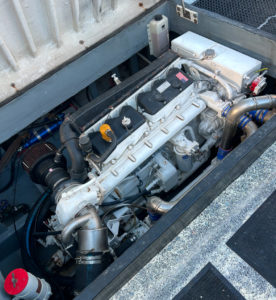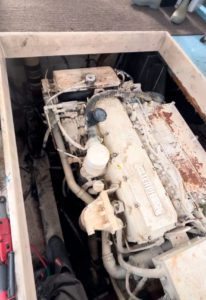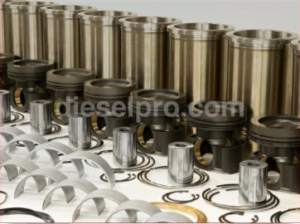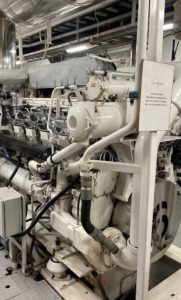
When it comes to maintaining, re-powering, or surveying a vessel, understanding your Caterpillar Marine engine’s history is essential. A Caterpillar Marine engine serial number lookup provides insight into your engine’s identity, confirming the model, year, duty rating, and build configuration.
Just as important as the serial number is the arrangement number. Together, the ESN (Engine Serial Number) and AN (Arrangement Number) provide the complete picture of your Caterpillar Marine engine.
Whether you’re servicing a 3208, troubleshooting a 3406, or sourcing parts for a C32, knowing how to locate and decode both numbers ensures you order the right components and avoid costly mistakes.
What Is a Caterpillar Marine Engine Serial Number?

Every Caterpillar Marine engine has a unique Engine Serial Number (ESN). This number is more than just a stamp on the block or a plate on the valve cover — it is the engine’s permanent identity. Much like a VIN (Vehicle Identification Number) on an automobile, the ESN encodes critical information about the engine family, the factory where it was built, its original configuration, and its year of manufacture. For marine operators, surveyors, and service providers, this number is the single most important reference point when working with a Caterpillar Marine engine.
Why Caterpillar Uses Serial Numbers
Caterpillar has produced marine engines for decades across multiple model families, from the well-known 3100 series (3116, 3126), to the 3200 series (3208), to the 3400 series (3406, 3408, 3412), and on up to the 3500 series (3512, 3516, 3520) and today’s modern C-Series (C7, C18, C32, C280). Within each family, hundreds of variations exist. Engines may be configured for high-speed yachts, deep-sea trawlers, tugboats, ferries, or auxiliary generator sets. Without a serial number, it would be nearly impossible to distinguish between these variations.
By assigning a unique ESN to every engine, Caterpillar ensures that each unit can be tracked throughout its lifecycle. The serial number acts as a permanent link to the factory build sheet, which records everything from piston type and turbocharger configuration to emissions certification.
What an ESN Can Tell You
At first glance, a Caterpillar ESN looks like a short combination of numbers and letters, often starting with a prefix. While the format has changed slightly over the decades, the meaning remains the same: the ESN connects your physical engine to Caterpillar’s global records.
By decoding or looking up an ESN, you can uncover details such as:
-
Engine Model and Family – Whether the engine is a 3116, 3406E, or C18.
-
Production Year – Essential for ordering the correct parts, since components may change between production runs.
-
Factory of Origin – Caterpillar manufactures engines in multiple facilities worldwide, and the ESN identifies the specific plant.
-
Duty Cycle Rating – Marine engines are classified into duty ratings (M1 through M5) that define their expected power output and operating profile. The ESN helps confirm the rating.
-
Configuration Details – Certain ESNs indicate special build features such as keel cooling, heat exchanger setups, electronic vs. mechanical fuel systems, and exhaust orientation.
Why the ESN Is Critical in Marine Applications

Marine environments place extreme demands on engines, and operators need absolute confidence in their equipment. An ESN provides a reliable reference point for:
-
Ordering Correct Replacement Parts and Overhaul Kits
-
Even within the same engine family, part numbers can vary significantly. A 3406 from 1985 may not use the same pistons, injectors, or gaskets as a 3406E from 1999.
-
Overhaul kits are particularly dependent on ESNs because Caterpillar often issued updates mid-production. Using the ESN ensures you receive the kit designed for your exact build.
-
-
Matching Service Manuals and Wiring Diagrams
-
Caterpillar produces detailed technical documentation for each engine, but not all manuals apply to every version of a model. By using the ESN, technicians can access the correct diagrams and instructions. This avoids costly downtime caused by referencing the wrong materials.
-
-
Verifying Duty Cycle Ratings (M1–M5)
-
Caterpillar assigns marine engines duty ratings based on their intended workload.
-
M1 engines are designed for continuous heavy-duty operation, such as commercial fishing vessels or tugboats.
-
M5 engines are configured for intermittent high-output use, common in performance yachts.
-
-
The ESN ties directly to the engine’s rating, ensuring owners know whether their unit was built for continuous service or for lighter, high-speed operation.
-
-
Supporting Warranty, Surveys, and Resale Documentation
-
Marine surveyors often use ESNs to verify an engine’s authenticity and production year during vessel sales.
-
Warranty claims also require the ESN to confirm coverage.
-
Resale values are closely tied to verified engine identity. A buyer is far more confident in purchasing a vessel with documented Caterpillar engines backed by ESN records.
-
ESN and Arrangement Number: Working Together
While the ESN identifies the engine, Caterpillar also assigns an Arrangement Number (AN) that describes the exact factory build. Two engines with consecutive ESNs could have very different ANs if one was built for a fishing trawler and the other for a generator.
Together, the ESN + AN combination ensures you can identify both the identity and the configuration of your Caterpillar Marine engine. This is why Diesel Pro Power always requests both numbers when helping customers select parts.
Real-World Examples
-
Example 1: Caterpillar 3406E Marine
A vessel operator contacts Diesel Pro Power needing an overhaul kit for a 3406E. The ESN reveals the engine was built in 1998 with a mechanical fuel system. By referencing the ESN, the sales team ensures the kit includes the correct liner pack, piston design, and gasket set. Without the ESN, the operator might receive parts for a later 3406E electronic configuration, leading to costly downtime.
-
Example 2: Caterpillar C18 ACERT Marine
Two identical yachts each carry Caterpillar C18 ACERT engines. However, one is configured with an M1 duty rating for commercial applications, while the other has an M5 rating for high-speed pleasure craft. The ESNs allow Diesel Pro Power to identify these differences instantly and supply the correct parts, preventing performance mismatches.
-
Example 3: Caterpillar 3208 Marine
The 3208 series has been out of production for decades, but many vessels still rely on them. An owner may struggle to determine which version of the 3208 they have. By providing the ESN, Diesel Pro Power can confirm the year, configuration, and supply compatible parts that fit legacy models without confusion.
Why ESNs Are Trusted in the Marine Industry

Caterpillar engines are used in commercial fleets, government vessels, offshore rigs, and private yachts around the world. The ESN system provides consistency across all of these applications. Whether an engine is powering a 3516 in a cargo vessel or a C32 in a superyacht, the serial number ensures that Caterpillar and its dealers can trace its origin and provide the right parts decades after production.
ESNs and Digital Support
In today’s connected world, ESNs are also essential for accessing digital resources:
-
CAT’s Online Parts Portal requires ESNs to pull the correct diagrams and technical updates.
-
Service Information Systems (SIS) use ESNs to tailor manuals and service instructions.
-
Diesel Pro Power’s Sales Representatives use ESNs provided by customers to cross-check their own internal databases, ensuring the customer receives exactly what they need.
The Bottom Line
A Caterpillar Marine Engine Serial Number is not just a number — it is the key to your engine’s entire history and support system. It ensures accuracy when ordering replacement parts, prevents costly mistakes in repairs, and provides confidence during surveys and resale.
For owners and operators, always record your engine’s ESN and keep it with your vessel’s logbook. For parts and service, provide both the ESN and Arrangement Number to Diesel Pro Power. With these identifiers, you can be certain you are getting the correct support for your Caterpillar Marine engine, whether it’s a 3116, a 3412, a 3516, or a modern C32.
What Is a Caterpillar Arrangement Number?

The arrangement number (AN) is one of the most important identifiers on a Caterpillar Marine engine, yet it is often misunderstood. While the engine serial number (ESN) identifies the engine’s unique identity and production run, the arrangement number specifies the exact configuration of the engine as it was originally built at the factory.
In other words, if the ESN is your engine’s fingerprint, the arrangement number is its blueprint. It tells you precisely what components were installed, how the cooling system was designed, and which accessories or sub-systems were fitted when the engine left Caterpillar’s assembly line.
What the Arrangement Number Covers
The arrangement number is critical because Caterpillar engines are built in countless variations to suit different marine applications. Two engines from the same model family can look identical on the outside but be very different internally. The AN provides that clarity by documenting features such as:
-
Cylinder head and piston type – The AN confirms compression ratio, piston crown design, and head casting version. This is crucial when selecting overhaul kits, as pistons and liners often differ between arrangements.
-
Turbocharger and aftercooler setup – Marine engines can be turbocharged differently depending on duty rating and emissions standards. The AN indicates whether the unit uses an air-to-water aftercooler, keel cooler, or jacket-water cooled turbo.
-
Fuel system configuration – Some engines within the same model family were built with mechanical fuel injection, while later versions may have electronic fuel control (such as EUI or HEUI systems). The AN confirms the correct system for your build.
-
Cooling system – Marine engines are often configured for either heat exchanger cooling or keel cooling, and the AN distinguishes between the two. Ordering the wrong water pump or cooler without checking the AN can lead to parts that do not fit your system.
-
Exhaust orientation and accessories – Depending on whether an engine was destined for a tugboat, yacht, ferry, or generator set, Caterpillar arranged exhaust elbows, manifolds, and accessory drives differently. The AN ensures you know exactly which orientation you have.
Why Arrangement Numbers Matter
Consider two Caterpillar 3406 Marine engines. Both may carry ESNs indicating they are part of the 3406 family, but one could have been built for a heavy-duty fishing trawler with continuous rating, while the other was configured for a high-output yacht. Without the arrangement number, it would be impossible to know which pistons, turbocharger, and aftercooler apply to each engine.
The arrangement number eliminates this guesswork. It ensures that parts, service instructions, and overhaul kits are matched to your engine’s exact build specification.
ESN and AN: Always Used Together
The engine serial number (ESN) and the arrangement number (AN) should always be used together when ordering parts, troubleshooting, or requesting technical support. The ESN confirms the model and production range, while the AN provides the configuration details.
For example:
-
A Caterpillar C18 Marine engine with ESN prefix JRE and AN 348-5678 may be configured for an M1 duty rating with heat exchanger cooling.
-
Another C18 with a similar ESN prefix but AN 349-1123 may be configured for an M5 duty rating with keel cooling and different pistons.
To the untrained eye, both engines appear to be C18s — but the arrangement numbers reveal the critical differences.
Working With Diesel Pro Power
At Diesel Pro Power, we always ask customers to provide both the serial number and the arrangement number. This combination allows our sales team to:
-
Identify the precise build of your Caterpillar Marine engine
-
Eliminate confusion when selecting overhaul kits, cylinder heads, water pumps, or fuel system components
-
Prevent costly downtime caused by ordering incorrect parts
-
Support legacy engines such as the 3208 or 3412, as well as modern C18 and C32 engines
By using both numbers, Diesel Pro Power ensures that every customer receives the right part, the first time.
The Bottom Line
The arrangement number is Caterpillar’s way of documenting your engine’s exact build configuration. It is the key to understanding the differences between engines of the same model family and is absolutely essential for accurate parts selection. Always record both your ESN and AN, and provide them together when contacting Diesel Pro Power for parts or service. Doing so guarantees that the support you receive is tailored to your engine’s true specifications.
Where to Find the Serial Number and Arrangement Number

Both numbers are normally displayed on the engine information plate, but can also be stamped into the block.
3100 Series (3116, 3126)
-
Data plate on the valve cover or intake manifold lists both ESN and AN.
-
Stamped into the block on the left-hand side.
3200 Series (3208)
-
Data plate on the rocker cover lists ESN and AN.
-
Serial stamped into the block above the injection pump.
3400 Series (3406, 3408, 3412)
-
Serial and arrangement numbers located on the rocker cover plate or timing cover.
-
Stamped into block near the flywheel housing.
3500 Series (3512, 3516, 3520)
-
Large brass or steel plates mounted to the block list both ESN and AN.
-
ESN also stamped into both sides of the block.
Modern C-Series (C7, C18, C32, C280)
-
Data plate on the valve cover or timing cover lists both ESN and AN.
-
ESN also stamped into the forward, port side of the block.
Caterpillar Marine Serial Number Prefix Reference

| Prefix | Engine Model / Family | Additional Information |
|---|---|---|
| 7CJ | 3116 Marine | Common in medium-duty marine vessels; often paired with heat exchanger cooling; mechanical fuel system. |
| 5EN | 3116 Marine | Alternate build; seen in smaller commercial fishing boats; ESN plate usually on valve cover. |
| 1ZJ | 3126 Marine | Successor to 3116; widely used in yachts and patrol craft; early versions mechanical, later electronic (HEUI). |
| 2WG | 3116/3126 Marine | Variant prefix; often found on auxiliary power units in commercial marine settings. |
| 03Z | 3208 Marine | Legacy V8; popular in small yachts; typically mechanical injection; no longer in production but widely supported. |
| 90N | 3208 Marine | Found in many U.S.-built yachts from 1970s–1990s; continuous-duty and high-output ratings available. |
| 5YF | 3208 Marine | Alternate 3208 marine prefix; parts compatibility depends on AN. |
| 2WB | 3406B Marine | Early B-series marine engine; mechanical fuel system; continuous duty. |
| 2KR | 3406 Marine | Widely used in commercial fishing trawlers and tugs; mechanical fuel system. |
| 4FD | 3406 Marine | Industrial/marine overlap; can be keel-cooled or heat exchanger cooled. |
| 6TB | 3406 Marine | Additional 3406 marine configuration; check AN for cooling setup. |
| 9HB | 3406 Marine | Prefix often tied to genset and auxiliary applications. |
| 3ER | 3406C Marine | C-series improvements; higher HP ratings; more common in mid-1990s builds. |
| 4RG | 3406C Marine (Genset) | Generator-set variant of 3406C; built for auxiliary power. |
| 6BR | 3406E Marine | Early electronic marine engines; introduction of ECMs. |
| 4MG | 3406E / 3408 Marine | Transitional electronic prefix; common in mid-1990s. |
| 6RJ | 3408 Marine | Industrial/marine hybrid; mechanical fuel system; robust continuous-duty use. |
| 9TD | 3408 Marine | Large-displacement mechanical; found in offshore vessels. |
| 67U | 3408 Marine | Classic 3408 marine builds; common in heavy-duty tugs and commercial craft. |
| BFF | 3408 Reman Marine | Remanufactured version of 3408 for marine use; available through CAT dealers. |
| 9SZ | 3412 Marine | Large-displacement marine engine; propulsion for ferries and offshore craft. |
| 30Z | 3412 Marine | Alternate prefix; mechanical configuration. |
| Z2D | 3412E Marine | Electronic version of the 3412; supports higher HP and better fuel management. |
| 5JJ | 3412E Marine | Used in machine/marine crossover builds; check AN carefully. |
| 4CR | 3412E Marine | Common in genset versions of 3412. |
| G5B | 3512 Marine | Large engine for tugs, ferries, offshore vessels; mechanical and electronic versions. |
| 4KC | 3512 Marine | Alternate prefix; industrial and marine builds. |
| 2AF | 3512 Marine | Continuous-duty builds; heavy propulsion and genset applications. |
| 5AW | 3512 Marine (Genset) | Dedicated generator set configurations; auxiliary power. |
| 3MS | 3512 Marine | Seen in petroleum/marine crossover builds. |
| S2X | 3516 Marine | High-horsepower propulsion for large ships, offshore rigs. |
| 35Z | 3516 Marine | Earlier 3516 builds; common in 1990s vessels. |
| 67Z | 3512 Marine | Used in large ferries and OSVs; AN required for duty cycle rating. |
| 6ZN | 3516 Marine (Gas) | Gas-powered marine versions; auxiliary power or LNG applications. |
| RLB | C32 Marine | Modern high-performance engine; electronic; available in duty ratings M1–M5. |
| SMP | C32 Marine (Petroleum) | Petroleum/marine crossover; adapted for offshore drilling support vessels. |
| WDR | C32 Marine (Genset) | Generator-set marine builds; auxiliary and emergency power. |
| CKH | C7 ACERT Marine | Compact engine for light commercial vessels; electronic control. |
| JRA | C7 Marine (Industrial) | Prefix seen in smaller generator and patrol craft builds. |
| JRE | C18 ACERT Marine | Popular engine for yachts and commercial craft; flexible duty ratings. |
| WJH | C18 Marine (Industrial) | Industrial configuration; often adapted for marine use. |
| X4R | C15 Marine | Mid-displacement marine propulsion and auxiliary. |
| X6X | C18 Marine (Power Module) | Packaged propulsion/power modules; yacht and workboat applications. |
| STR | C27 Marine (Genset) | Marine generator sets for large commercial vessels. |
| TWM | C27 Industrial/Marine | Industrial builds adapted for marine propulsion. |
| SXC | C32 Marine (Genset) | Dedicated electronic genset builds; large vessel auxiliary power. |
| TLD | C32 Industrial/Marine | Heavy-duty builds for offshore drilling rigs and ships. |
| 07Y | G3306 Marine (Gas) | Gas-engine variant; auxiliary and genset applications. |
| 3NK | G3412 Marine (Gas) | Large gas-engine variant for propulsion/gensets. |
| WPM | G3508 Gas Marine | Gas-engine builds; generator-based marine applications. |
| WPP | G3512 Gas Marine | Larger gas builds for vessels and offshore platforms. |
| WPS | G3516 Gas Marine | High-output gas variant for marine power modules. |
| R7A | G3412 Marine (Genset) | Marine genset version; common in auxiliary applications. |
| R7E | G3406 Marine (Genset) | Smaller genset prefix used on support vessels. |
| GLS | C11 Marine (Industrial) | Smaller-displacement engine used in auxiliary configurations. |
| DLA | 3408 Marine (Reman) | Remanufactured marine prefix; sold through Cat Reman program. |
| ECP | 3408E Marine (Reman) | Remanufactured electronic version; yacht and OSV use. |
| PTH | 3508C Marine (Genset) | Generator sets; auxiliary large-vessel power. |
| CAJ | PM3412 Power Module Marine | Packaged marine power modules; offshore rigs. |
| BPY | PM3508 Power Module Marine | Modular marine propulsion unit; heavy-duty. |
| CFD | PM3516 Power Module Marine | Largest packaged propulsion unit for offshore/military use. |
Work With Diesel Pro Power to Identify Your Engine

While charts and lists are useful, the most reliable way to match your Caterpillar Marine engine to the right parts is by working with a Diesel Pro Power sales representative.
Our team can:
-
Verify your serial number and arrangement number
-
Confirm your engine’s year, duty cycle rating, and configuration
-
Help you select the correct replacement parts, overhaul kits, or accessories
-
Provide guidance for both legacy models like the 3208 and 3406, and modern engines like the C18 and C32
By providing both your ESN and AN, our sales team can eliminate guesswork and ensure that you get exactly the parts your engine requires.
Final Thoughts

A Caterpillar Marine engine’s serial number and arrangement number together are the keys to its identity. From sourcing injectors for a 3126, to ordering water pumps for a 3412, or matching overhaul kits for a 3516, using both numbers ensures that you get the right parts every time.
Diesel Pro Power supports the full Caterpillar Marine lineup, from the 3100 and 3200 series, to the proven 3400 and 3500 series, and the latest C-series models. Contact our team with your serial and arrangement numbers, and we’ll help you keep your vessel running with confidence.



 Free US Calls: 1-888-433-4735
Free US Calls: 1-888-433-4735 International: 305-545-5588
International: 305-545-5588